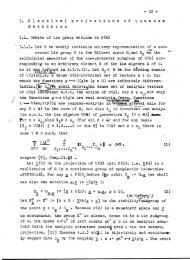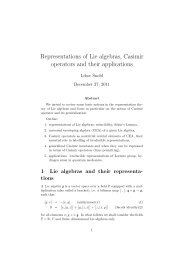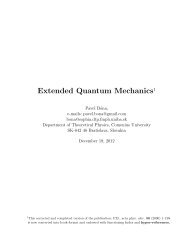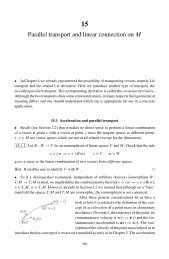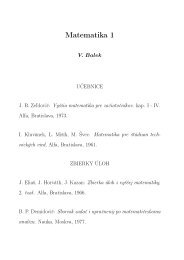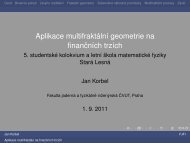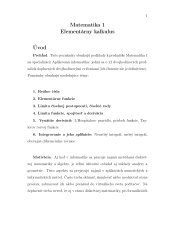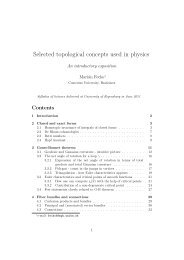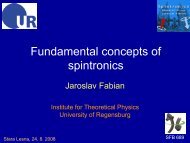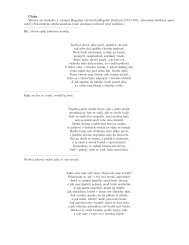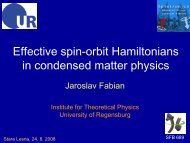Quantum Field Theory I
Quantum Field Theory I
Quantum Field Theory I
Create successful ePaper yourself
Turn your PDF publications into a flip-book with our unique Google optimized e-Paper software.
3.1. NAIVE APPROACH 95<br />
1<br />
2E jV<br />
Thefinitevolumenormalizationaffectsalsothenormalizationofstates, since<br />
〈⃗p|⃗p ′ 〉 = 2E ⃗p (2π) 3 δ 3 (⃗p−⃗p ′ ) → 2E ⃗p Vδ ⃗P P ⃗′. The relation from the beginning of<br />
this paragraphbetween |S fi | 2 (or |T fi | 2 for f ≠ i) and the corresponding probability<br />
thereforebecomes: probability for f≠i = |T fi | 2 ∏ n<br />
j=1<br />
. Note that using<br />
the finite volume normalization, i.e. having discrete rather than continuous labeling<br />
of states, we should speak about probabilities rather than probability<br />
densities. Nevertheless, for the volume V big enough, this discrete distribution<br />
of states is very dense — one may call it quasi-continuous. In that case it is<br />
technically convenient to work with the probability quasi-density, defined as the<br />
probability of decay into any state |f〉 = |⃗p 1 ,...,⃗p m 〉 within the phase-space<br />
element d 3 p 1 ...d 3 p m . This is, of course, nothing else but the sum of the probabilities<br />
over all states within this phase-space element. If all the probabilities<br />
within the considered phase-space element were equal (the smaller the phasespace<br />
element is, the better is this assumption fulfilled) one could calculate the<br />
said sum simply by multiplying this probability by the number of states within<br />
the phase-space element. And this is exactly what is commonly used (the underlying<br />
reasoning is just a quasi-continuous version of the standard reasoning<br />
of integral calculus). And since the number of states within the interval d 3 p<br />
is ∆n x ∆n y ∆n z = V d 3 p/(2π) 3 one comes to the probability quasi-density (for<br />
f ≠ i) being equal to |T fi | 2 ∏ n<br />
j=1<br />
1<br />
2E jV<br />
∏ m<br />
k=1<br />
probability<br />
quasidensity = VT ∏<br />
m<br />
(2π)4 δVT(p 4 f −p i )|M fi | 2<br />
V d 3 p<br />
(2π) 3 . So for f ≠ i one has<br />
j=1<br />
d 3 p<br />
(2π) 3 2E j<br />
n ∏<br />
j=m+1<br />
1<br />
2E j V .<br />
Comparing this to the expressions for dΓ and dσ given in the Introductions<br />
(see p.12) we realize that we are getting really close to the final result. We just<br />
have to get rid of the awkward factors T and T/V in the probability quasidensities<br />
for one and two initial particles respectively (and to find the relation<br />
between 1/E A E B and [(p A .p B ) 2 −m 2 A m2 B ]−1/2 in caseofthe crosssection). This<br />
step, however, is quite non-trivial. The point is that even if our result looks as<br />
if we are almost done, actually we are almost lost. Frankly speaking, the result<br />
is absurd: for the time T being long enough, the probability exceeds 1.<br />
At this point we should critically reexamine our procedure and understand<br />
the source of the unexpected obscure factor T. Instead, we are going to follow<br />
the embarrassing tradition of QFT textbooks and use this evidently unreliable<br />
result for further reasoning, even if the word reasoning used for what follows is<br />
a clear euphemism 26 . The reason for this is quite simple: the present author is<br />
boldly unable to give a satisfactory exposition of these issues 27 .<br />
26 A fair comment on rates and cross sections is to be found in the Weinberg’s book (p.134):<br />
The proper way to approach these problems is by studying the way that experiments are<br />
actually done, using wave packets to represent particles localized far from each other before a<br />
collision, and then following the time history of these superpositions of multiparticle states.<br />
In what follows we will instead give a quick and easy derivation of the main results, actually<br />
more a mnemonic than a derivation, with the excuse that (as far as I know) no interesting<br />
open questions in physics hinge on getting the fine points right regarding these matters.<br />
27 This incapability seems to be shared by virtually all authors of QFT textbooks (which<br />
perhaps brings some relief to any of them). There are many attempts, more or less related<br />
to each other, to introduce decay rates and cross sections. Some of them use finite volume,<br />
some use wave-packets (but do not closely follow the whole time evolution, as suggested by<br />
Weinberg’s quotation), some combine the two approaches. And one feature is common to all<br />
of them: they leave much to be desired.



